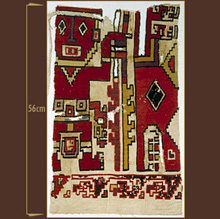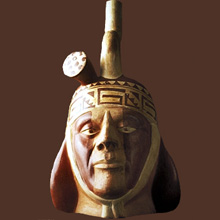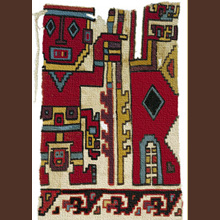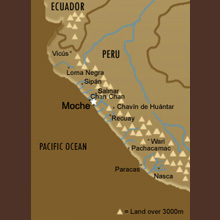let the objects speak
Moche - Textile Fragment

-
This large textile fragment was produced by the Moche people of Peru's north coast around A.D. 650-850. Scholars term textiles of this type "Moche-Wari" because while they were made by the Moche people using distinctly coastal techniques, they contain symbols and designs representative of the dominant Wari people of the central highlands. This textile depicts a male figure, shown holding two hooked staffs. Beside him is a giant composite creature with a deer or camelid head (note the blunt teeth). The hook-shaped heads above the creature's ear suggest it may have had a body like the staffs held by the human figure. Depicting inanimate objects as animals is a common practice in Andean art, which conveys an association between the object and the qualities that the animal embodies.

Who
Due to the sparseness of textile preservation in the region, the Moche are far better known for their ceramic art. Moche ceramics, unlike those of most other Andean cultures, tended to be strikingly realistic. They developed a natural, though often idealized form of true portraiture. Vessels like this one were mold made in the form of a head with a stirrup spout. Many examples of portrait heads are known, and include some 50 recognizable individuals. This Moche ceramic portrait is of a male, likely of considerable importance. We do not know who he was, but he was not a deity. He was a real person, who almost certainly lived in the Chicama, Moche, or Viru valley, sometime around A.D. 500-700.

What
This textile would have been considerably more vibrant and colourful in its original state. Over the long term, some elements found in certain natural dyes and mordants cause decay and entire colours can disappear while others still remain. Examination of this object showed small blue fibres in areas of the piece where no other yarn remained. This indicated which areas, now empty, were originally blue. We were able to restore the blue colour on a digital image of the piece. We were also able to restore faded elements to the same richness of colour as was found on better preserved sections of the textile. The image on the left is the end result.

Where
Almost two millennia ago the Moche people began to build large ceremonial centres, palaces, and extensive trade networks throughout the Andes. As the map indicates, the homeland of the Moche is quite a distance from the site of Wari and in a very different geographical zone. Yet, the imagery on the textile belongs to the Wari style. While the Moche were independent of the Wari politically, the great reach of the Wari expansion left its mark on Moche art. This piece is a north coastal interpretation of themes and images defined in the central highlands, the Wari heartland.